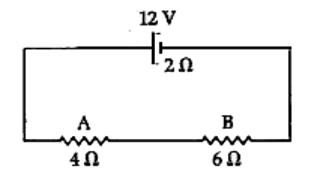A battery of e.m.f. 15 V and internal resistance 3Ω is connected to two resistors 3 Ω and 6 Ω connected in parallel. Find :
the p.d. between the terminals of the battery,
To find the potential difference (p.d.) between the terminals of the battery, we can follow these steps:
Step 1: Identify the given values
- E.M.F of the battery (E) = 15 V
- Internal resistance of the battery (r) = 3 Ω
- Resistor 1 (R1) = 3 Ω
- Resistor 2 (R2) = 6 Ω
Step 2: Calculate the equivalent resistance of the parallel resistors
The formula for the equivalent resistance (R') of two resistors in parallel is given by:
1R′=1R1+1R2
Substituting the values:
1R′=13+16
Finding a common denominator (which is 6):
1R′=26+16=36=12
Thus, the equivalent resistance of the parallel resistors is:
R′=2Ω
Step 3: Calculate the total resistance in the circuit
The total resistance (R_total) in the circuit is the sum of the internal resistance of the battery and the equivalent resistance of the parallel resistors:
Rtotal=R′+r=2Ω+3Ω=5Ω
Step 4: Calculate the current flowing through the circuit
Using Ohm's Law, we can find the current (I) flowing through the circuit:
I=ERtotal=15V5Ω=3A
Step 5: Calculate the potential difference across the terminals of the battery
The potential difference (V) between the terminals of the battery can be calculated using the formula:
V=E−I⋅r
Substituting the known values:
V=15V−(3A⋅3Ω)=15V−9V=6V
Final Answer
The potential difference between the terminals of the battery is 6 V.
---
- E.M.F of the battery (E) = 15 V
- Internal resistance of the battery (r) = 3 Ω
- Resistor 1 (R1) = 3 Ω
- Resistor 2 (R2) = 6 Ω
The formula for the equivalent resistance (R') of two resistors in parallel is given by:
1R′=1R1+1R2
Substituting the values:
1R′=13+16
Finding a common denominator (which is 6):
1R′=26+16=36=12
Thus, the equivalent resistance of the parallel resistors is:
R′=2Ω
The total resistance (R_total) in the circuit is the sum of the internal resistance of the battery and the equivalent resistance of the parallel resistors:
Rtotal=R′+r=2Ω+3Ω=5Ω
Using Ohm's Law, we can find the current (I) flowing through the circuit:
I=ERtotal=15V5Ω=3A
The potential difference (V) between the terminals of the battery can be calculated using the formula:
V=E−I⋅r
Substituting the known values:
V=15V−(3A⋅3Ω)=15V−9V=6V
The potential difference between the terminals of the battery is 6 V.
Topper's Solved these Questions
- CURRENT ELECTRICITYBOOK - ICSECHAPTER - CURRENT ELECTRICITYEXERCISE - EXERCISE-8(C)
22 Videos
- CURRENT ELECTRICITYBOOK - ICSECHAPTER - CURRENT ELECTRICITYEXERCISE - EXERCISE-8(C) MULTIPLE CHOICE TYPE)
2 Videos
- CURRENT ELECTRICITYBOOK - ICSECHAPTER - CURRENT ELECTRICITYEXERCISE - EXERCISE-8(B) (MULTIPLE CHOICE TYPE)
3 Videos
- CALORIMETRYBOOK - ICSECHAPTER - CALORIMETRYEXERCISE - EXERCISE-11(B) (NUMERICALS)
15 Videos
- ELECTRO-MAGNETISM BOOK - ICSECHAPTER - ELECTRO-MAGNETISM EXERCISE - EXERCISE-10 (C) NUMERICALS
1 Videos
Similar Questions
A battery of e.m.f. 15 V and internal resistance 3Ω is connected to two resistors 3 Ω and 6 Ω connected in parallel. Find :
the current in 6 Ω resistor.
View SolutionA battery of e.m.f. 15 V and internal resistance 3Ω is connected to two resistors 3 Ω and 6 Ω connected in parallel. Find :
the current through the battery,
View SolutionA battery of e.m.f. 15 V and internal resistance 3Ω is connected to two resistors 3 Ω and 6 Ω connected in parallel. Find :
the current in 3 Ω resistor,
View SolutionA battery of e.m.f. 12 V and internal resistance 2 Ω is connected with two resistors A and B of resistance 4 Ω and 6 Ω respectively joined in series.

Find The potential difference across 6 Ω Resistor.
View SolutionA battery of e.m.f. 15 V and internal resistance 2 Ω is connected to two resistors of resistances 4 ohm and 6 ohm joined in series. Find the electrical energy spent per minute in 6 ohm resistor.
View SolutionA battery of e.m.f. 12 V and internal resistance 2 Ω is connected with two resistors A and B of resistance 4 Ω and 6 Ω respectively joined in series.

Find Electrical energy spent per minute in 4 Ω Resistor.
View SolutionA cell of e.m.f. 1.5 V, internal resistance 1 Ω is connected to the resistors of 4 Ω and 20Ω in series. Draw a circuit diagram and calculate :
the current in the circuit,
View SolutionTwo resistors having resistance 4 Ω and 6 Ω are connected in parallel. Find their equivalent resistance.
View SolutionA cell of e.m.f. 1.5 V, internal resistance 1 Ω is connected to the resistors of 4 Ω and 20Ω in series. Draw a circuit diagram and calculate :
the p.d. across each resistor
View SolutionA battery of emf 2 V and initial resistance 1Ω is
connected across terminals A and B of the circuit shown
in figure
 .
.
View Solution
